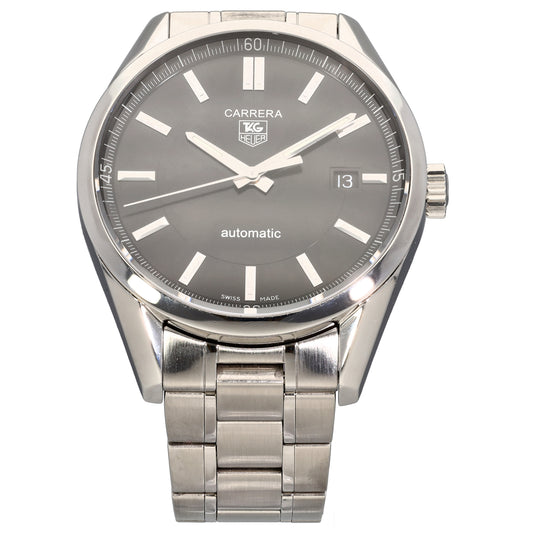
All watches — regardless of style, design, or brand — are powered by a mechanism called a movement, which is essentially the engine that drives the watch. Sometimes known as a calibre, the movement refers to all the moving parts of a watch that allow it to keep time.
There are four different types of watch movement, all of which function differently. This guide will help you to understand how each movement works, including information on the benefits and negative aspects of every type, to help you find your ideal watch. We'll cover the four types of movement, including:
- Manual watches
- Automatic watches
- Quartz watches
- Kinetic watches
What is a mechanical watch?
Mechanical watches keep time using an intricate system of springs, gears, and cogs, which are powered by a winding spring that stores and slowly releases the energy needed to power the watch. This type of movement does not use a battery or other electrical power source, which means mechanical watches will always have a traditional dial, with a set of hands, rather than a digital display. Manual and automatic watches are classed as mechanical.
Quartz watches are powered by a battery, meaning they are not classed as mechanical watches. They tend to be constructed more simply than mechanical watches, as the battery removes the need for complex clockwork mechanisms. Kinetic watches contain a mechanical movement, but they also use a battery, making them something of a hybrid between the two types.
Because quartz and kinetic watches are electrically powered, they may have a digital display, unlike a mechanical watch, which only ever has a dial. A quartz or kinetic watch might also have electrically powered special features, like lighting or an alarm.
What is a manual watch?

A manual watch — sometimes called a winding watch — is a timepiece that uses a mechanical movement and must be regularly wound by hand in order to keep accurate time. The frequency of this varies between different designs, but most manual watches will require daily winding.
How do manual watches work?
A manual watch is composed of moving parts which are wound up by hand. The movement in a mechanical watch is extremely intricate, comprising 50–300 separate parts. The central component is the mainspring, which is wound up manually and then gradually unwinds, providing the energy needed to power the rest of the movement.
Are manual watches good?
Manual watches are often seen as collectable luxury items, valued for the exquisite craftsmanship behind each design. Unlike automatic watches, they do not need to be worn regularly in order to wind up, meaning they can be left in storage or only worn occasionally. They do require daily winding, which means they may not be for everyone, especially if you are likely to forget to wind up your watch. However, many mechanical watch owners enjoy the opportunity to interact with their timepiece each day, making the daily winding process a draw for many people.
How often the watch requires winding depends on the brand and the individual design of the watch but, for most, it tends to be at least once a day. The watch is wound using the crown at the edge of the watch face, typically taking between 20 and 30 turns to fully wind up the mechanism. If a manual movement sounds like the choice for you, then be sure to take a look at our collections by classic watchmakers like Omega, Tudor, and Rolex.
What is an automatic watch?

An automatic watch has a self-winding movement that is powered by the motions of the wearer during use. This means, while it is classed as a mechanical watch, it does not require manual winding. The majority of mechanical watches produced today have automatic movements.
How do automatic watches work?
In an automatic watch, the movement is powered by a mainspring, which slowly releases the energy needed to power the watch as it unwinds. The mainspring is wound up by a specially created set of wheels and a rotor weight. This is moved by the natural motion of the wearer's wrist during use, spinning the rotor weight and winding up the mainspring. This means that, as long as the watch is worn most days, it will not need to be wound up manually, nor does it require an electrical power source.
Are automatic watches good?
As the mechanism is fully automated, an automatic watch does not require an electrical power source to function, meaning it does not need batteries. It also does not need regular winding, unlike a manual watch. However, an automatic watch will need to be worn almost every day in order to keep accurate time. If the watch is to be left in storage, it should be kept on a watch winder, which will keep the movement ticking.
The component parts of an automatic watch tend to be very high quality, as hard-wearing parts are needed in order to keep the internal mechanisms running smoothly. For instance, synthetic rubies are often used as bearings, because they can withstand the high temperatures caused by friction, preventing the internal mechanisms from wearing down. The quality of the component parts means that automatic watches are usually built to last, and can even function for generations if properly cared for and serviced.
Much like their manual counterparts, the meticulous craftsmanship of an automatic is a major draw for buyers. The labour-intensive crafting process means that automatic watches tend to be more expensive than electrical designs, and so are usually considered luxury items, many of which will be kept for a lifetime and may even become family heirlooms. If you're looking for a timepiece in a traditional mechanical style, but don't want to have to wind it up daily, then browse our collection of preowned automatic watches from iconic brands such as Rolex, TAG Heuer, and Cartier.
What is a quartz watch?

A quartz watch is a battery-powered timepiece that uses a piece of quartz crystal to keep time. When you run an electrical current through a quartz crystal, it will vibrate at an almost perfectly constant frequency. This consistent rate of vibration allows the watch to keep very precise time.
Because this type of watch relies on an electrical power source, it does not need a complex mechanical clockwork movement or mainspring in order to function.
Are quartz watches good?
High-end quartz watches can keep very accurate time — sometimes to within a few seconds a year. Unlike mechanical types, they don’t have many moving parts, meaning they’re also more durable than automatic and manual watches. The streamlined simplicity of the design also allows more room for specialist features within the watch: for example, compasses, altimeters, thermometers, alarms and illumination.
As quartz timepieces are made using fewer components, they also tend to be much lighter and slimmer than their mechanical counterparts. You can find light, fashionable quartz designs in our collection of watches by classic watchmaking brands such as Chopard, Cartier, and Ebel.
What is a kinetic watch?

A kinetic watch uses a battery that is charged by the wearer's movements during use. It also uses a small piece of quartz crystal in order to regulate accurate time. This means it contains aspects of both mechanical and quartz design.
How do kinetic watches work?
A kinetic watch uses a mechanical movement that is powered by a self-charging battery. Kinetic watches have a small mechanism on the back of the movement, which spins whenever the wearer moves their wrist. This movement is converted into electrical energy, and stored in a rechargeable battery. This battery then provides the energy needed to power the watch.
Kinetic watches also have a piece of synthetic quartz crystal integrated into the design. When an electrical current passes through the crystal, it starts to vibrate at a constant frequency. This gives the timepiece something consistent to measure time against, allowing the watch to tell accurate time.
Are kinetic watches good?
As kinetic watches use both a mechanical movement and a quartz crystal, they could be described as halfway between an automatic and quartz watch. So, they feature many of the benefits of each type: much like automatic watches, they don't require manual winding, and they keep time as accurately as a quartz design.
However, they also offer some benefits which automatic watches don't: for example, a kinetic watch can continue to operate for up to six months, even if it is not worn every day. Kinetic styles by certain brands, like Seiko, can even go into sleep mode for storage, and continue to tell accurate time as late as four years afterwards. However, the batteries will need to be changed eventually, and this can be relatively expensive compared to replacing the batteries in a quartz watch.
Quartz or automatic: which type of watch movement is best?
While each type of watch movement has its benefits and negative qualities, the best watch for you will depend entirely on your lifestyle and personal taste. There is no definitive best type of movement: ultimately, only you can decide which type of watch is the right choice for you.
This chart provides an at-a-glance comparison of the advantages and disadvantages of each type of movement, to help you establish which sort of watch will suit you best.
What else should I consider?
When shopping for a watch, you might also want to take into account what sort of activities you'll be doing while wearing your watch, and whether you'll need a waterproof design: you can read more about how water resistance is gauged in our guide.
For many people, a watch is primarily a style statement. That means that a watch may not be worn every day, but only to suit certain outfits or occasions. If you don't plan to wear your watch every day, then you might want to avoid automatic or kinetic types, as these need regular wear in order to function. Instead, you might want to shop for a quartz or kinetic type, and go for a particular brand or design which will suit the style you had in mind. Remember, we offer a huge collection of preowned watches, including styles for both men and for women by a range of legendary watchmakers, so be sure to take a look at what we've got in stock.
With so many different watch movements to choose from, finding the best design can seem overwhelming. But, if you carefully consider the advice we've listed here, you should have no problem working out which movement type will suit your lifestyle and personal tastes.
If you still need some more help with your decision, or you have questions about any of the watches in our collection, then don’t hesitate to contact our team, who will be happy to help you find the perfect watch.
































